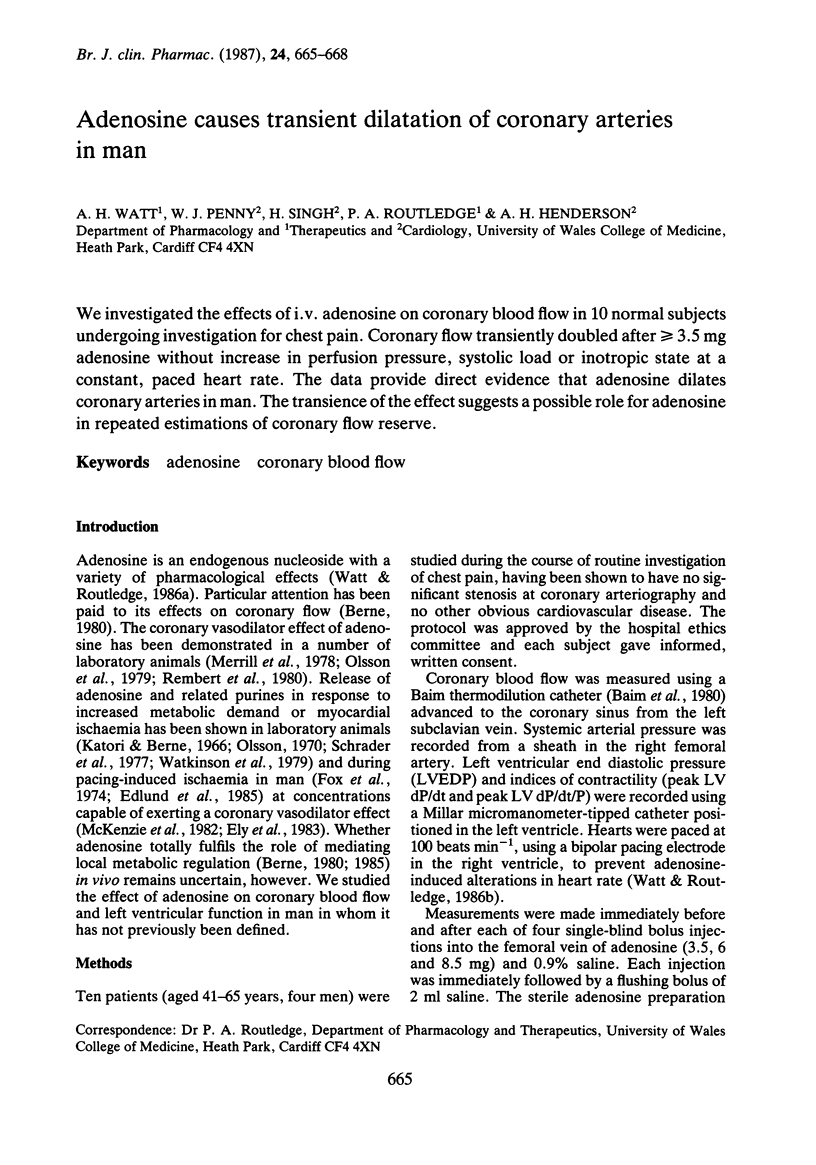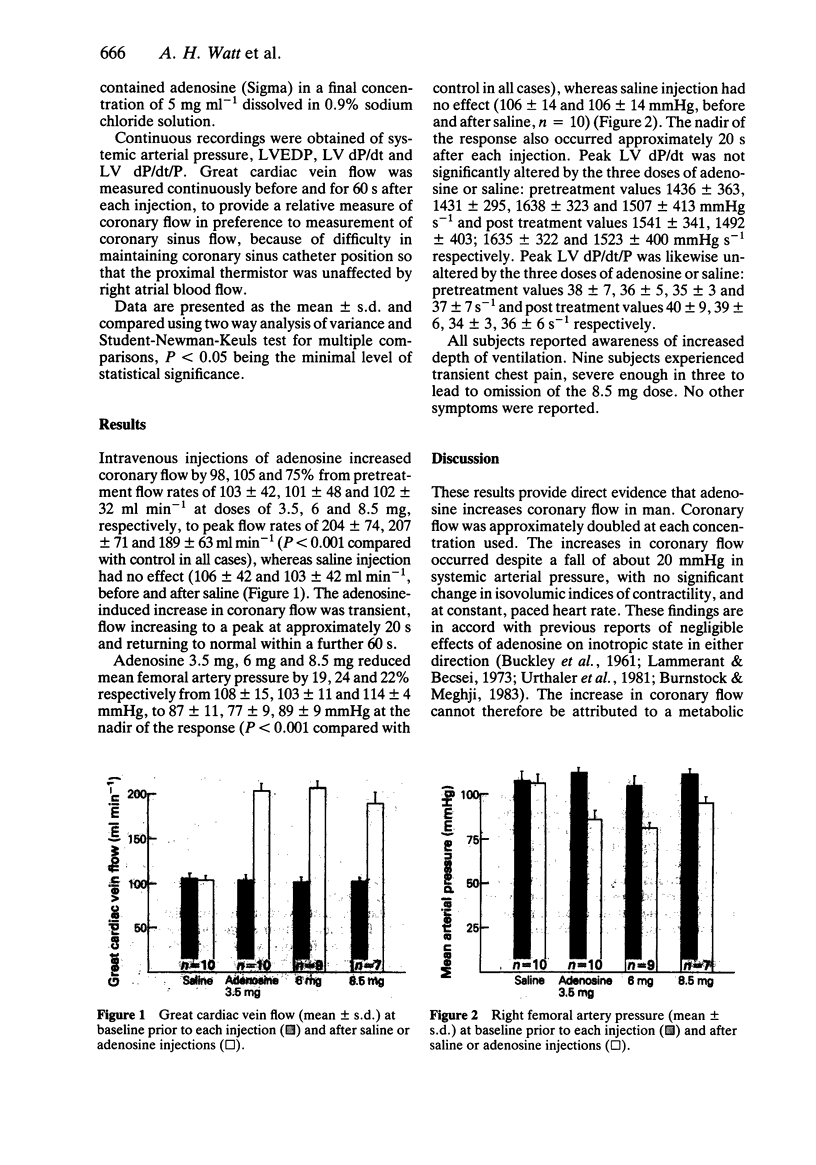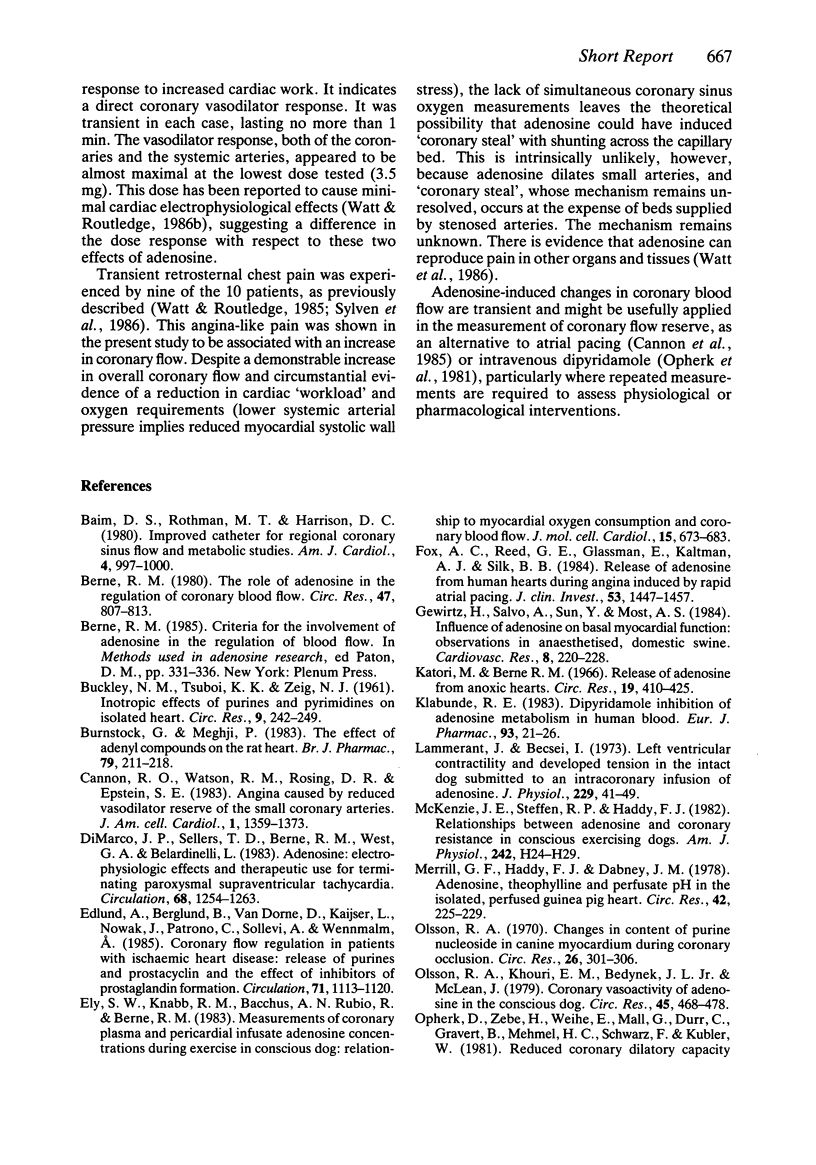Abstract
We investigated the effects of i.v. adenosine on coronary blood flow in 10 normal subjects undergoing investigation for chest pain. Coronary flow transiently doubled after greater than or equal to 3.5 mg adenosine without increase in perfusion pressure, systolic load or inotropic state at a constant, paced heart rate. The data provide direct evidence that adenosine dilates coronary arteries in man. The transience of the effect suggests a possible role for adenosine in repeated estimations of coronary flow reserve.
Full text
PDF



Selected References
These references are in PubMed. This may not be the complete list of references from this article.
- Angina pectoris-like pains provoked by intravenous adenosine. Br Med J (Clin Res Ed) 1986 Aug 23;293(6545):504–505. doi: 10.1136/bmj.293.6545.504-a. [DOI] [PMC free article] [PubMed] [Google Scholar]
- Baim D. S., Rothman M. T., Harrison D. C. Improved catheter for regional coronary sinus flow and metabolic studies. Am J Cardiol. 1980 Dec 1;46(6):997–1000. doi: 10.1016/0002-9149(80)90357-4. [DOI] [PubMed] [Google Scholar]
- Berne R. M. The role of adenosine in the regulation of coronary blood flow. Circ Res. 1980 Dec;47(6):807–813. doi: 10.1161/01.res.47.6.807. [DOI] [PubMed] [Google Scholar]
- Burnstock G., Meghji P. The effect of adenyl compounds on the rat heart. Br J Pharmacol. 1983 May;79(1):211–218. doi: 10.1111/j.1476-5381.1983.tb10514.x. [DOI] [PMC free article] [PubMed] [Google Scholar]
- Cannon R. O., 3rd, Watson R. M., Rosing D. R., Epstein S. E. Angina caused by reduced vasodilator reserve of the small coronary arteries. J Am Coll Cardiol. 1983 Jun;1(6):1359–1373. doi: 10.1016/s0735-1097(83)80037-0. [DOI] [PubMed] [Google Scholar]
- DiMarco J. P., Sellers T. D., Berne R. M., West G. A., Belardinelli L. Adenosine: electrophysiologic effects and therapeutic use for terminating paroxysmal supraventricular tachycardia. Circulation. 1983 Dec;68(6):1254–1263. doi: 10.1161/01.cir.68.6.1254. [DOI] [PubMed] [Google Scholar]
- Edlund A., Berglund B., van Dorne D., Kaijser L., Nowak J., Patrono C., Sollevi A., Wennmalm A. Coronary flow regulation in patients with ischemic heart disease: release of purines and prostacyclin and the effect of inhibitors of prostaglandin formation. Circulation. 1985 Jun;71(6):1113–1120. doi: 10.1161/01.cir.71.6.1113. [DOI] [PubMed] [Google Scholar]
- Ely S. W., Knabb R. M., Bacchus A. N., Rubio R., Berne R. M. Measurements of coronary plasma and pericardial infusate adenosine concentrations during exercise in conscious dog: relationship to myocardial oxygen consumption and coronary blood flow. J Mol Cell Cardiol. 1983 Oct;15(10):673–683. doi: 10.1016/0022-2828(83)90257-2. [DOI] [PubMed] [Google Scholar]
- Fox A. C., Reed G. E., Glassman E., Kaltman A. J., Silk B. B. Release of adenosine from human hearts during angina induced by rapid atrial pacing. J Clin Invest. 1974 May;53(5):1447–1457. doi: 10.1172/JCI107693. [DOI] [PMC free article] [PubMed] [Google Scholar]
- Gewirtz H., Salvo A., Sun Y., Most A. S. Influence of adenosine on basal myocardial function: observations in anaesthetised, domestic swine. Cardiovasc Res. 1984 Apr;18(4):220–228. doi: 10.1093/cvr/18.4.220. [DOI] [PubMed] [Google Scholar]
- Katori M., Berne R. M. Release of adenosine from anoxic hearts. Relationship to coronary flow. Circ Res. 1966 Aug;19(2):420–425. doi: 10.1161/01.res.19.2.420. [DOI] [PubMed] [Google Scholar]
- Klabunde R. E. Dipyridamole inhibition of adenosine metabolism in human blood. Eur J Pharmacol. 1983 Sep 16;93(1-2):21–26. doi: 10.1016/0014-2999(83)90026-2. [DOI] [PubMed] [Google Scholar]
- Lammerant J., Becsei I. Left ventricular contractility and developed tension in the intact dog submitted to an intracoronary infusion of adenosine. J Physiol. 1973 Feb;229(1):41–49. doi: 10.1113/jphysiol.1973.sp010125. [DOI] [PMC free article] [PubMed] [Google Scholar]
- McKenzie J. E., Steffen R. P., Haddy F. J. Relationships between adenosine and coronary resistance in conscious exercising dogs. Am J Physiol. 1982 Jan;242(1):H24–H29. doi: 10.1152/ajpheart.1982.242.1.H24. [DOI] [PubMed] [Google Scholar]
- Merrill G. F., Haddy F. J., Dabney J. M. Adenosine, theophylline, and perfusate pH in the isolated, perfused guinea pig heart. Circ Res. 1978 Feb;42(2):225–229. doi: 10.1161/01.res.42.2.225. [DOI] [PubMed] [Google Scholar]
- Olsson R. A. Changes in content of purine nucleoside in canine myocardium during coronary occlusion. Circ Res. 1970 Mar;26(3):301–306. doi: 10.1161/01.res.26.3.301. [DOI] [PubMed] [Google Scholar]
- Olsson R. A., Khouri E. M., Bedynek J. L., Jr, McLean J. Coronary vasoactivity of adenosine in the conscious dog. Circ Res. 1979 Oct;45(4):468–478. doi: 10.1161/01.res.45.4.468. [DOI] [PubMed] [Google Scholar]
- Opherk D., Zebe H., Weihe E., Mall G., Dürr C., Gravert B., Mehmel H. C., Schwarz F., Kübler W. Reduced coronary dilatory capacity and ultrastructural changes of the myocardium in patients with angina pectoris but normal coronary arteriograms. Circulation. 1981 Apr;63(4):817–825. doi: 10.1161/01.cir.63.4.817. [DOI] [PubMed] [Google Scholar]
- Rembert J. C., Boyd L. M., Watkinson W. P., Greenfield J. C., Jr Effect of adenosine on transmural myocardial blood flow distribution in the awake dog. Am J Physiol. 1980 Jul;239(1):H7–13. doi: 10.1152/ajpheart.1980.239.1.H7. [DOI] [PubMed] [Google Scholar]
- Schrader J., Haddy F. J., Gerlach E. Release of adenosine, inosine and hypoxanthine from the isolated guinea pig heart during hypoxia, flow-autoregulation and reactive hyperemia. Pflugers Arch. 1977 May 6;369(1):1–6. doi: 10.1007/BF00580802. [DOI] [PubMed] [Google Scholar]
- Sylvén C., Beermann B., Jonzon B., Brandt R. Angina pectoris-like pain provoked by intravenous adenosine in healthy volunteers. Br Med J (Clin Res Ed) 1986 Jul 26;293(6541):227–230. doi: 10.1136/bmj.293.6541.227. [DOI] [PMC free article] [PubMed] [Google Scholar]
- Watkinson W. P., Foley D. H., Rubio R., Berne R. M. Myocardial adenosine formation with increased cardiac performance in the dog. Am J Physiol. 1979 Jan;236(1):H13–H21. doi: 10.1152/ajpheart.1979.236.1.H13. [DOI] [PubMed] [Google Scholar]
- Watt A. H., Reid P. G., Stephens M. R., Routledge P. A. Adenosine-induced respiratory stimulation in man depends on site of infusion. Evidence for an action on the carotid body? Br J Clin Pharmacol. 1987 Apr;23(4):486–490. doi: 10.1111/j.1365-2125.1987.tb03081.x. [DOI] [PMC free article] [PubMed] [Google Scholar]
- Watt A. H., Routledge P. A. Adenosine stimulates respiration in man. Br J Clin Pharmacol. 1985 Nov;20(5):503–506. doi: 10.1111/j.1365-2125.1985.tb05108.x. [DOI] [PMC free article] [PubMed] [Google Scholar]
- Watt A. H., Routledge P. A. Adenosine: an importance beyond ATP. Br Med J (Clin Res Ed) 1986 Dec 6;293(6560):1455–1456. doi: 10.1136/bmj.293.6560.1455. [DOI] [PMC free article] [PubMed] [Google Scholar]
- Watt A. H., Routledge P. A. Transient bradycardia and subsequent sinus tachycardia produced by intravenous adenosine in healthy adult subjects. Br J Clin Pharmacol. 1986 May;21(5):533–536. doi: 10.1111/j.1365-2125.1986.tb02838.x. [DOI] [PMC free article] [PubMed] [Google Scholar]


